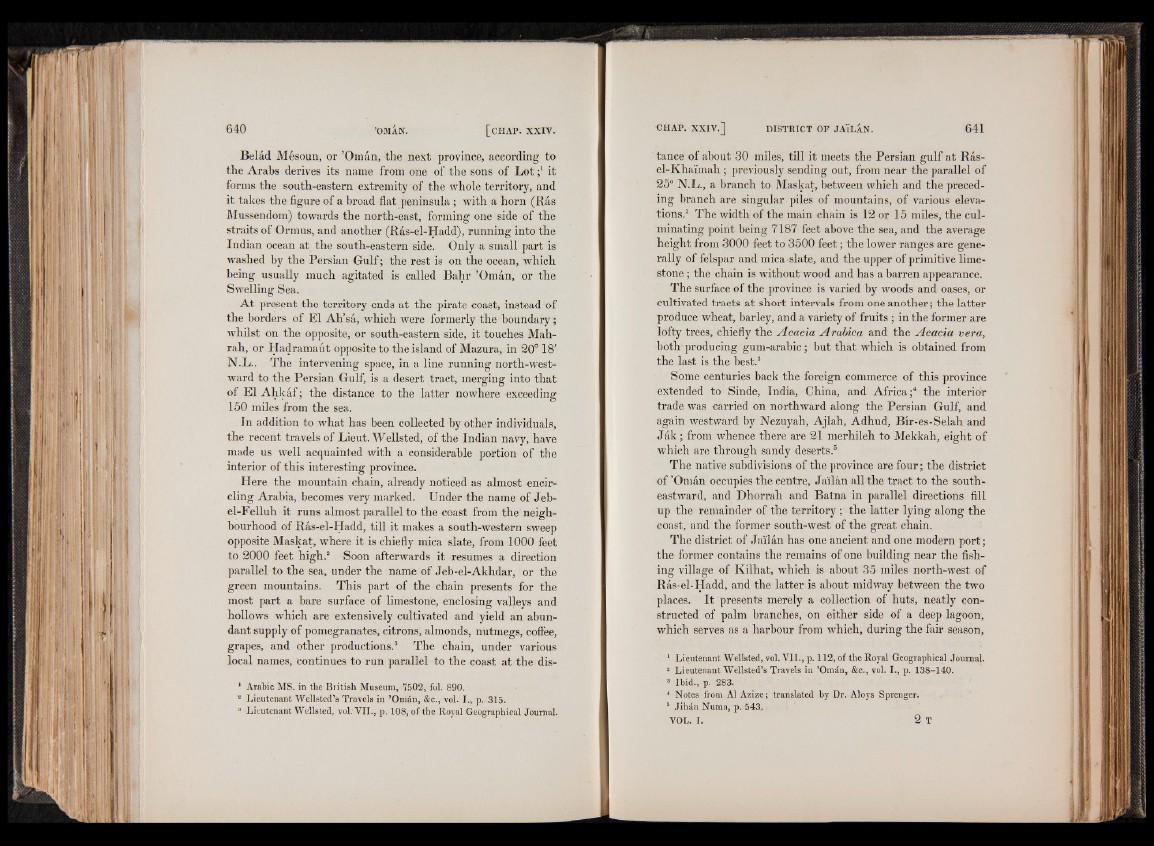
Belád Mésoun, or ’Omán, the next province, according to
the Arabs derives its name from one of the sons of L o t i t
forms the south-eastern extremity of the whole territory, and
it takes the figure of a broad flat peninsula ; with a horn (Rás
Mussendom) towards the north-east, forming one side of the
straits of Ormus, and another (Rás-el-Hadd), running into the
Indian ocean at the south-eastern side. Only a small part is
washed by the Persian Gulf; the rest is on the ocean, which
being usually much agitated is called Bahr ’Omán, or the
Swelling Sea.
At present the territory ends at the pirate coast, instead of
the borders of El Ah’sá, which were formerly the boundary;
whilst on the opposite, or south-eastern side, it touches Mah-
rah, or Hadramaut opposite to the island of Mazura, in 20° 18'
N.L.. The intervening space, in a line running north-westward
to the Persian Gulf, is a desert tract, merging into that
of El Ahkáf; the distance to the latter nowhere exceeding
150 miles from the sea.
In addition to what has been collected by other individuals,
the recent travels of Lieut. Wellsted, of the Indian navy, have
made us well acquainted with a considerable portion of the
interior of this interesting province.
Here the mountain chain, already noticed as almost encircling
Arabia, becomes very marked. Under the name of Jeb-
el-Felluh it runs almost parallel to the coast from the neighbourhood
of Rás-el-Hadd, till it makes a south-western sweep
opposite Maskat, where it is chiefly mica slate, from 1000 feet
to 2000 feet high.2 Soon afterwards it resumes a direction
parallel to the sea, under the name of Jeb-el-Akhdar, or the
green mountains. This part of the chain presents for the
most part a bare surface of limestone, enclosing valleys and
hollows which are extensively cultivated and yield an abundant
supply of pomegranates, citrons, almonds, nutmegs, coffee,
grapes, and other productions.3 The chain, under various
local names, continues to run parallel to the coast at the dis1
Arabic MS. in tlie British Museum, ^502, fol. 890.
s Lieutenant Wellsted’s Travels in ’Omán, &c., vol. I., p. 315.
3 Lieutenant Wellsted, vol. VII., p. 108, of the Royal Geographical Journal.
tance of about 30 miles, till it meets the Persian gulf at Rás-
el-Khaimah; previously sending out, from near the parallel of
25° N.L., a branch to Maskat, between which and the preceding
branch are singular piles of mountains, of various elevations.
1 The width of the main chain is 12 or 15 miles, the culminating
point being 7187 feet above the sea, and the average
height from 3000 feet to 3500 feet; the lower ranges are generally
of felspar and mica slate, and the upper of primitive limestone
; the chain is without wood and has a barren appearance.
The surface of the province is varied by woods and oases, or
cultivated tracts at short intervals from one another; the latter
produce wheat, barley, and a variety of fruits; in the former are
lofty trees, chiefly the Acacia Arabica and the Acacia vera,
both producing gum-arabic; but that which is obtained from
the last is the best.3
Some centuries back the foreign commerce of this province
extended to Sinde, India, China, and Africa;4 the interior
trade was carried on northward along the Persian Gulf, and
again westward by Nezuyah, Ajlah, Adhud, Bir-es-Selah and
Ják; from whence there are 21 merhileh to Mekkah, eight of
which are through sandy deserts.5
The native subdivisions of the province are four; the district
of ’Omán occupies the centre, Jailán all the tract to the southeastward,
and Dhorrah and Batna in parallel directions fill
up the remainder of the territory ; the latter lying along the
coast, and the former south-west of the great chain.
The district of Ja'ilán has one ancient and one modern port;
the former contains the remains of one building near the fishing
village of Kilhat, which is about 35 miles north-west of
Rás-el-Hadd, and the latter is about midway between the two
places. It presents merely a collection of huts, neatly constructed
of palm branches, on either side of a deep lagoon,
which serves as a harbour from which, during the fair season,
1 Lieutenant Wellsted, vol. V II., p. 112, of the Royal Geographical Journal.
a Lieutenant Wellsted’s Travels in ’Omán, &c., vol. I., p. 138-140.
a Ibid., p. 283.
4 Notes from A1 Azize; translated by Dr. Aloys Sprenger.
5 Jihán Numa, p. 543,
VOL. I . 2 T